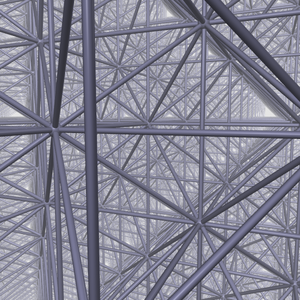- Disphenoid tetrahedral honeycomb
-
Disphenoid tetrahedral honeycomb 
Type convex uniform honeycomb dual Cell type 
disphenoid tetrahedronFace types isosceles triangle {3} Cells/edge 4 or 6 Cells/vertex 24 Symmetry group Im3m Dual Bitruncated cubic honeycomb Properties cell-transitive, face-transitive, vertex-transitive The disphenoid tetrahedral honeycomb is a space-filling tessellation (or honeycomb) in Euclidean 3-space made up of identical nonregular tetrahedral cells.
The stretched tetrahedron cells are called disphenoids. Cells are face-transitive with 4 identical isosceles triangle faces.
This honeycomb's vertex figure is a tetrakis cube: 24 disphenoids meet at each vertex. The union of these 24 disphenoids forms a rhombic dodecahedron. Each edge of the tessellation is surrounded by either four or six disphenoids, according to whether it forms the base or one of the sides of its adjacent isosceles triangle faces respectively. When an edge forms the base of its adjacent isosceles triangles, and is surrounded by four disphenoids, they form an irregular octahedron. When an edge forms one of the two equal sides of its adjacent isosceles triangle faces, the six disphenoids surrounding the edge form a special type of parallelepiped called a trigonal trapezohedron.
The disphenoid tetrahedral honeycomb is the dual of the uniform bitruncated cubic honeycomb.
See also
References
- Gibb, William (1990), "Paper patterns: solid shapes from metric paper", Mathematics in School 19 (3): 2–4, reprinted in Pritchard, Chris, ed. (2003), The Changing Shape of Geometry: Celebrating a Century of Geometry and Geometry Teaching, Cambridge University Press, pp. 363–366, ISBN 0-521-53162-4.
- Senechal, Marjorie (1981), "Which tetrahedra fill space?", Mathematics Magazine (Mathematical Association of America) 54 (5): 227–243, doi:10.2307/2689983, JSTOR 2689983.

This Polychora article is a stub. You can help Wikipedia by expanding it.
